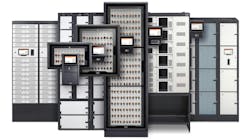As Hurricane Ian approaches landfall as a powerful Category 4 storm, data centers across Florida are taking steps to prepare their facilities and staff for several days of disruption as the massive storm crawls across the state.
The storm has intensified as it approaches the Gulf coast of Florida, with 155-mile an hour winds that bring the potential for serious flooding from storm surge and wind damage, as well as several days of heavy rain that could drop more than 12 inches of rain in some areas of Florida.
Florida data centers have lots of experience with hurricanes, and are taking precautions to make sure their buildings are as prepared as possible, stocking up on generator fuel and positioning staff for extended shifts in case the the storm creates travel challenges.
Ian arrives a year after Hurricane Ida hit the New Orleans area as a Category 4 storm, causing lengthy power outages after winds toppled the primary electric transmission towers serving the city.
A key part of a data center emergency operations plan is looking after staff that may need to remain at the data center for an extended period of time, even as a major storm threatens the area where they live. Other lessons from past hurricanes and regional disasters is the critical importance of diesel fuel to support emergency generators. Most data center operators have priority contracts for diesel fuel and can be resupplied during long-term events that require generator support.
Here’s a look at the potential impacts of Ian and how major data centers are preparing.
Landfall Area
The National Hurricane Center (NHC) is projecting “catastrophic” storm surge inundation of 12 to 18 feet above normal water levels in areas near Ian’s landfall. Many of these areas are under evacuation zones, meaning staff cannot stay to protect facilities. That includes businesses, governments and educational facilities with on-site data center facilities that would normally have admins keeping an eye on their equipment.
The metro area facing the highest projected storm surge is Fort Myers and Naples, where the NHC projects storm surges will exceed 9 feet. Several data centers operate in the area, including facilities in Ft. Myers operated by network operator Lumen and a Skylink Data Centers site in Naples.
Skylink describes its facility as “a bunker built in the middle upper floor of a newly built, freestanding office building” that is 40 feet above sea level and “capable of withstanding anything mother nature has in store.”
In Sarasota, Ringling College of Art and Design has closed its campus, including the data center that would normally provide communication and remote learning resources. The campus is several hundred yards from the Sarasota Bay, but about 75 miles north of the projected landfall.
“Campus technology resources will be going offline and we will be shutting down the campus data center to protect it,” the college said Monday. “Our Data Center will also be taken completely offline during our storm preparations. All academic technology services provided from our campus data center will be unavailable.” The college urged students to back up their network files and virtual desktops.
Tampa Area
The Tampa Bay region is facing significant impact from Ian, although the storm track has shifted just south, averting worst-case scenarios for storm surge, a particular risk for the area. There are about 25 data centers in the Tampa metro, including two Flexential facilities and a Cyxtera data center in Tampa, and a Cologix data center further inland in Lakeland .
“Flexential is leveraging over 20 years of experience in designing, building, and operating highly available and highly secure data centers,” said David Kidd, SVP of Governance, Risk, and Compliance at Flexential. “We have developed emergency management processes to support ongoing operations under extreme conditions. We have trained experts in data center operations serving as a part of our emergency mobile response team (aka “go-team”) who have traveled to augment our staff on site in Florida. Each member of our team is fully trained to keep our data centers operational under extreme conditions.
“Our on-site personnel have also confirmed that all emergency systems are operating properly, and that all supplies needed, including fuel, are ready if and when the storm arrives,” Kidd added. “Throughout any emergency the Flexential Support team man the Flexential Emergency Operations Center (EOC) to coordinate communications with our customers and our response teams.”
“Cyxtera’s business continuity procedures are comprehensive and include proactive planning for many scenarios, so our facilities remain resilient in the face of potential events like Hurricane Ian,” said Russell Cozart, SVP of marketing & product strategy for Cyxtera. “Last week, our business continuity and operations teams activated existing plans to ensure the availability and operability of facilities in Ian’s projected path.
“Our data center teams have completed all disaster preparedness procedures, including topping off fuel levels and testing all generators,” Cozart added. “Cyxtera will continue to coordinate with federal and state agencies throughout the duration of the event.”
Orlando
Orlando is home to about 10 data centers, with the largest being DataSite Orlando, which is now part of the CoreSite portfolio following the recent consolidation by the facility’s owner, American Tower Corp. It’s a 130,000 square foot data center, and outside the 500-year-floodplain, which may be important for Orlando-area operators if projections of heavy rainfall are realized.
“We have activated our emergency storm preparations in the Florida market and are monitoring the situation closely,” said Joseph Liccardo, Vice President of Data Center Field Operations at CoreSite, which also operates a data center in Miami.
Miami Area
Miami is the largest data hub in Florida, with more than 30 data centers, including the NAP of the America and landing stations for subsea communications cables. Although Miami is far from the projected landfall near Ft. Myers, the vast size of Hurricane Ian will bring heavy weather into South Florida, including tropical storm force winds of about 40 miles and hour, extended heavy rain, and the chance of tornadoes.
We will update this story as we hear from more operators.
About the Author



